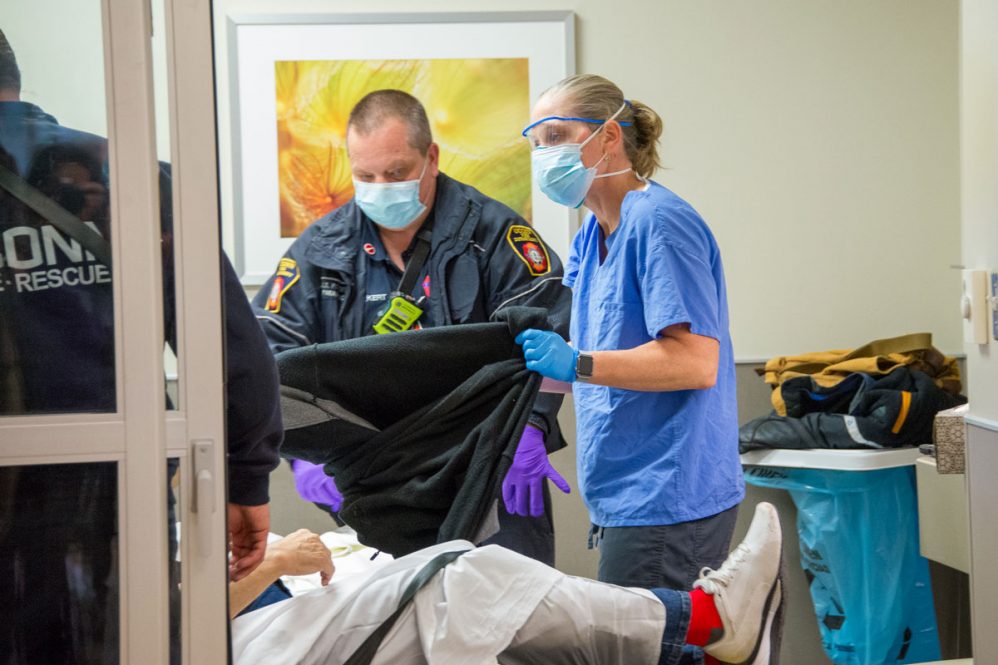“Keeping your doctor’s office in the loop is very important.”
—Dr. Alise Frallicciardi, UConn John Dempsey Hospital Emergency Department
While it’s not the most common problem the UConn John Dempsey Hospital Emergency Department sees in the winter, it could be the most avoidable.
It may seem obvious that you shouldn’t put your hand anywhere near the blades of a snowblower, but for some of us, that obvious wisdom goes out the window when a clog stops the machine from working. Where people get into trouble is not realizing the clog they think is safe to remove with the engine stopped could have caused a buildup of stored energy in the impeller. When it becomes unjammed, that built-up energy releases, enough to spin those blades again at a rate that can do serious damage.
“It’s lawnmowers too, and garbage disposals,” says Dr. Alise Frallicciardi, UConn Health’s medical director of emergency medicine. “It’s human nature: We see something not moving and we think it’s safe.”

If your machine doesn’t come with a rod-like tool to use to loosen a clog, something like a broom handle can save your fingers.
Slip-and-fall injuries, back ailments, and cardiovascular episodes from overexertion are the much more commonly seen snow-removal problems. The exertion can be especially dangerous to those with coronary artery disease risk factors like high blood pressure or high cholesterol.
“You can be active, go for walks, but shoveling is probably not the best activity,” Frallicciardi says. “If you are going to shovel, you have to make sure you’re breathing easy, not overexerting yourself, not using your lower back to shovel, using your legs and knees to lift that snow up, or better yet, push it out of the way instead of lifting and throwing.”
The cold complicates things too. It can make breathing more difficult for those with respiratory problems, and it can make it harder to detect body heat generated by exertion.
“You just have to be very conscious of your activity level when you’re out in the cold,” Frallicciardi says.
And that goes for winter recreational activities like skiing and snowboarding, which are common sources of orthopedic injuries like twisted knees and ankles and fractured wrists.
When COVID-19 Is an Emergency (and When It’s Not)
One of the more common presentations in the ED for the last 11 months or so is something that wasn’t prevalent from the start of the previous winter: possible COVID-19 illness. While the ED is equipped to handle highly contagious situations, it’s not always going to be the right place to go with a COVID scare.
“If you think you have been exposed to coronavirus and your symptoms are mild, such as a stuffy nose or mild sore throat, maybe a little bit of congestion, those don’t necessarily require a visit to the emergency department,” Frallicciardi says. “If you have chest pains or trouble breathing, those are things that should bring you to the emergency department. That’s the differentiator, the mild symptoms.”
What about loss of taste and smell?
“That’s a mild symptom,” Frallicciardi says. “You probably have COVID, and please be careful, quarantine, get tested and wear a mask, but you don’t need to be seen in the emergency department for lost taste and smell. The majority of people who come in with possible COVID-19 go home without the need for admission to the hospital.”
How ED Patients Can Help Themselves
Frallicciardi advises patients to call their regular doctor when they go to the emergency department. If it’s not possible to do so before or during the visit, even notifying the doctor’s office afterward can enhance overall care because other providers will be able to check the electronic health record and stay informed.
“Keeping your doctor’s office in the loop is very important, to let them know what’s going on,” she says. “Doctors really want to know if their patients are in the ED, and in some cases they can help advise the ED care team, maybe they can coordinate care, such as, ‘I can do that CAT scan in the outpatient setting,’ or ‘I did labs the other day.’ We’re all on the same team. We’re just trying to take care of everybody as cooperatively as we can.”
And when you’re not sure if what you’re dealing with rises to the level of requiring emergency care, a call to your doctor first could save you a trip to the ED.
But the standard advice of what always is an emergency is worth the reminder: Any signs of possible heart attack or stroke start a race against the clock for treatment to save heart muscle or brain tissue. In these cases, the best way to the ED is via ambulance, where EMTs can initiate care in the hospital by transmitting important information while in transit. Potential broken bones or other traumatic injuries, difficulty breathing, and overdoses are other examples of appropriate reasons to seek emergency care.
Learn more about the UConn John Dempsey Hospital Emergency Department.



